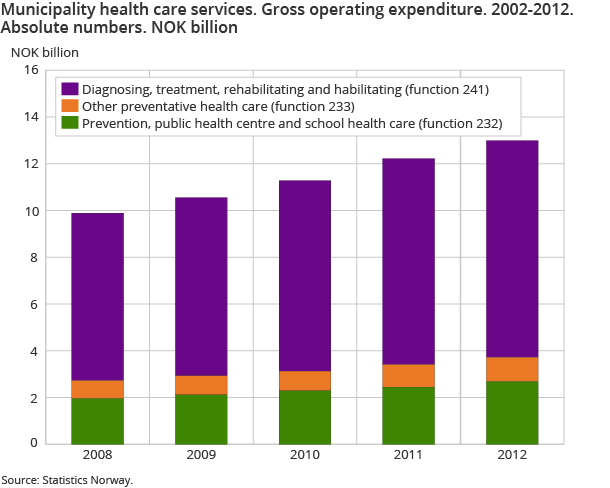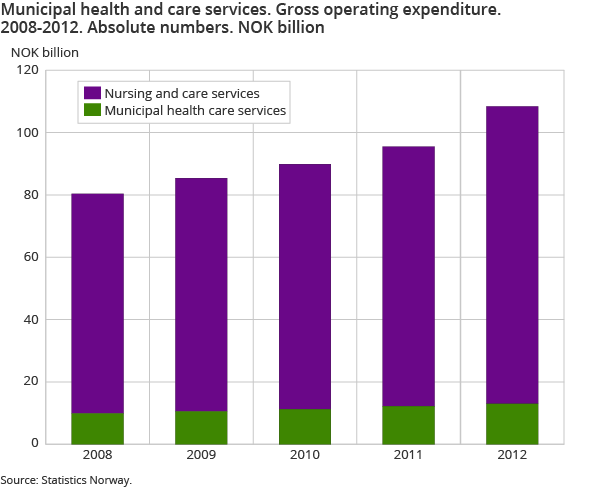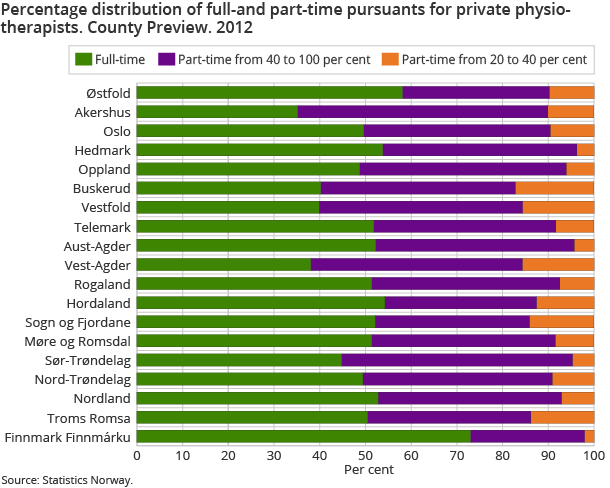Content
Published:
This is an archived release.
About 13 billion for municipal health care services
In 2012 roughly NOK 13 billion were used on municipal health care services. The municipalities have entered into more agreements with general practitioners within the framework of the list patient system, and the number of physicians increased from 2011 to 2012.
| 2012 | 2012 | 2011 - 2012 | 2008 - 2012 | |
|---|---|---|---|---|
| Absolute figures | Per 10 000 inhabitants | Percentage change1 | Percentage change1 | |
| 1Percentage change is based on absolute figures | ||||
| Corrected 3 February 2014. | ||||
| Man-years for physicians in the municipal health service | 5 020.2 | 9.9 | 3.8 | 10.8 |
| Man-years for physiotherapists | 4 429.3 | 8.8 | 3.1 | 2.2 |
| Absolute figures | Per inhabitant | Percentage change1 | Percentage change1 | |
| Gross operating expenditures in total | 12 989 983 | 2 571.6 | 6.4 | 31.4 |
| Preventive health care, (enviromental health), function 233 | 1 042 322 | 206.3 | 7.9 | 36.5 |
| Diagnosis, treatment and rehabilitation, function 241, consolidated accounts | 9 272 582 | 1 835.7 | 5.3 | 29.3 |
| Absolute figures | Per 10 000 inhabitants 0-20 years | Percentage change1 | Percentage change1 | |
| Preventive health care, school/health centre, function 232 | 2 675 079 | 2 026.6 | 9.6 | 36.9 |
| health centers and school health | 4 278.1 | 32.4 | 2.8 | .. |
Measured by gross operating expenditure the expenses related to municipal health care services have risen steadily for a few years and the increase continued from 2011 to 2012. The largest amount of expenditure is related to diagnosing, treatment, rehabilitating and habilitating. Among other things this includes basic grants for general practitioners, municipal casualty ward and physiotherapy. In 2012 the expenditure for these purposes was almost NOK 9.3 billion, which represents an increase of 5.3 per cent from 2011.
The largest increase in expenditure from 2011 to 2012 was related to prevention in the form of services provided by public health centres and school health care. This includes public health centre for children and youth, school health care at primary and secondary levels and at upper secondary school, and midwife services. In 2012 the expenditure of the municipalities for these purposes was approximately NOK 2.7 billion, which is an increase of 9.6 per cent from 2011.
The expenditure related to other preventative health services in the municipalities, for instance in the form of public health centres for elderly and immigrants respectively, amounted to above NOK 1 billion in 2012 and has increased by 8 per cent from 2011.
The Coordination Reform and financial means influence developments
The Coordination Reform in the Norwegian health services was implemented 1 January 2012. The reform includes some organizational changes and financial means which among other things means that expenditure on municipal health care services should be viewed in relation to those of the nursing and care services in the municipalities. From 1 January 2012 the previous municipal health care services and nursing and care services constitute what is referred to as municipal health and care services (kommunale helse- og omsorgstjenester).
The expenditure related to municipal health and care services in total, which includes both municipal health care services and nursing and care services in the municipalities, amounted to NOK 108 billion in 2012 and increased by 13.5 per cent from 2011. The financial means of the Coordination Reform have at least some influence on the growth from 2011 to 2012. First and foremost this is due to municipal co-financing of specialist health care services which amounted to above NOK 5 billion in 2012. Still there is reason to believe that the municipal responsibility for patients ready for discharge from hospitals in the specialist health care services also played its part, even though this is a cost item that is problematic to identify by means of municipality accounts.
Moreover the municipal expenditure related to emergency services should be mentioned even though this according to the Coordination Reform is to be a statutory task for the municipalities from 1 January 2016. In 2012 this totalled NOK 52 million.
More regular general practitioners
Over the years the municipalities enter into more agreements with general practitioners. At the same time the number of open patient lists (capacity to include more patients) within the list patient system is reduced. The number of agreements has increased from 4 212 in 2011 to 4 298 in 2012, while the number of open patient lists has decreased from 1 800 to 1 719 in the same period of time. Moreover the number of patient lists without a regular general practitioner and the number of patients registered on such patient lists is increasing. In 2011 there were 60 patient lists without a regular general practitioner and 41 834 patients registered to these lists, while the numbers for 2012 shows 71 patient lists and 42 811 patients respectively.
One in five regular general practitioners is an immigrant
At the end of 2012 there was a total of 4 279 persons who practiced as a regular general practitioner in the municipalities. Every year since 2002, which was the first whole year with a list patient system in Norway, about 20 per cent of the regular general practitioners have been immigrants. Yet there are some differences by centrality of municipalities and size of municipalities when it comes to the coverage of immigrant regular general practitioners. In the least central municipalities the immigrant regular general practitioners constituted 34 per cent of all regular general practitioners in 2012, while the same share was 18 per cent in the central municipalities. Moreover in the smallest municipalities with less than 2 000 inhabitants the immigrant regular general practitioners made up for 44 per cent of all the regular general practitioners, while the share was 17 per cent in the largest municipalities with more than 50 000 inhabitants.
Most of the immigrant regular general practitioners are European-born, and Germans are those most represented. By the end of 2012 the European-born constituted about 60 per cent of all the immigrant regular general practitioners, while almost 30 per cent was born in an Asian country. There are significantly fewer regular general practitioners in Norway who are born in Africa, North and Latin America, South America and Oceania.
The man-years measured by full-time equivalents are increasing
The number of physicians in municipal health care is still growing. In 2012 there was a total of 5 020 full-time equivalents (FTEs) in the municipalities, which means an increase of 4 per cent from 2011. The FTEs are by large related to diagnosing, treatment, rehabilitating and habilitating. In 2012 these totalled 4 094 FTEs and increased by 3.3 per cent from 2011. However the picture of FTEs related to public health centres and school health care is different. In 2012 the FTEs for these services amounted to 206 FTEs, which represented a decrease of 2 per cent from 2011 and 4.5 per cent from 2008.
Contact
-
Trond Ekornrud
E-mail: trond.ekornrud@ssb.no
tel.: (+47) 48 13 70 09
-
Merete Thonstad
E-mail: merete.thonstad@ssb.no
tel.: (+47) 99 30 70 72
-
Solveig Stølan
E-mail: solveig.stolan@ssb.no
tel.: (+47) 48 19 37 83



